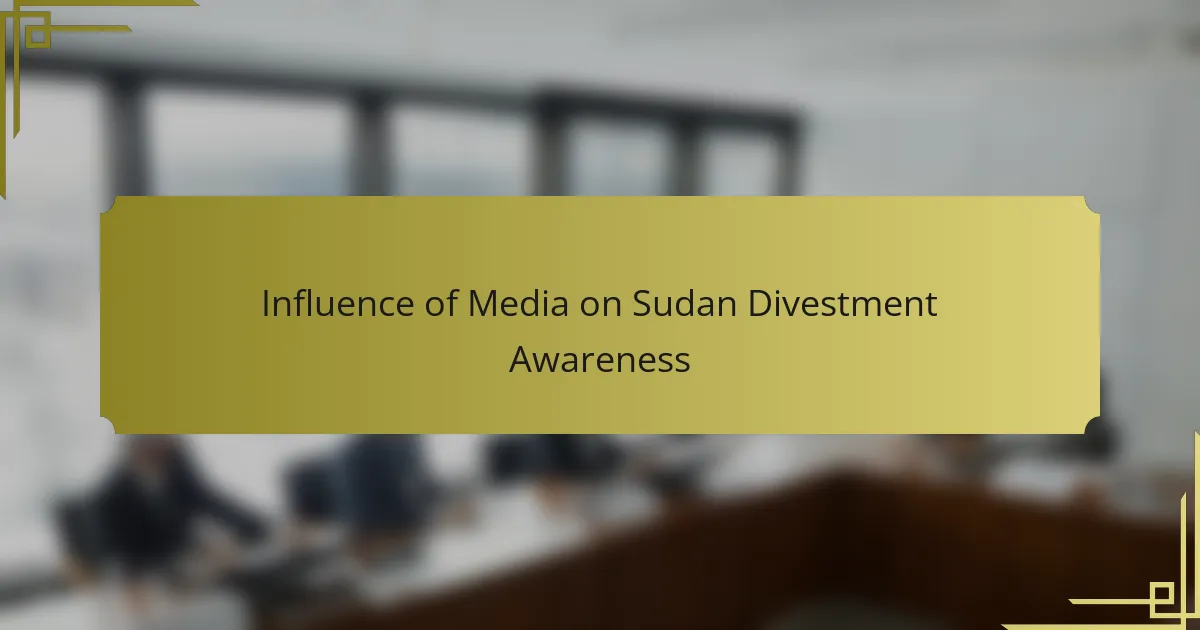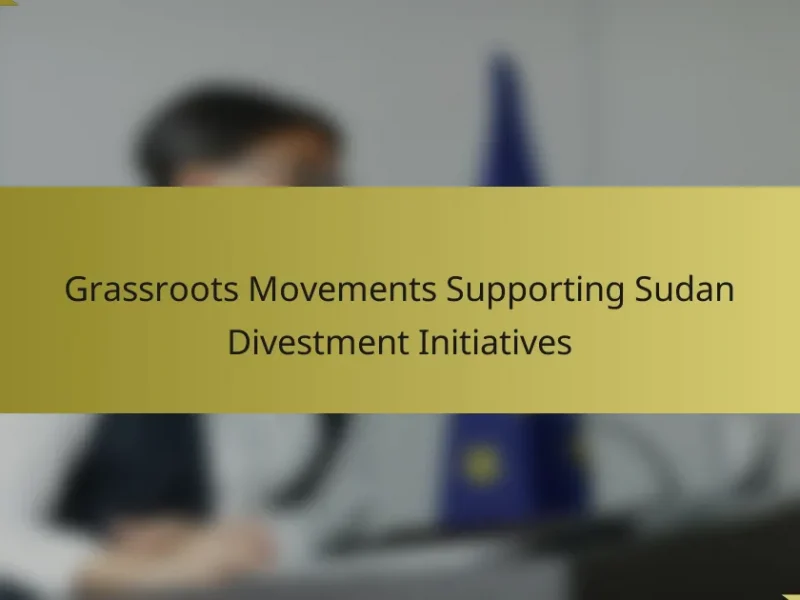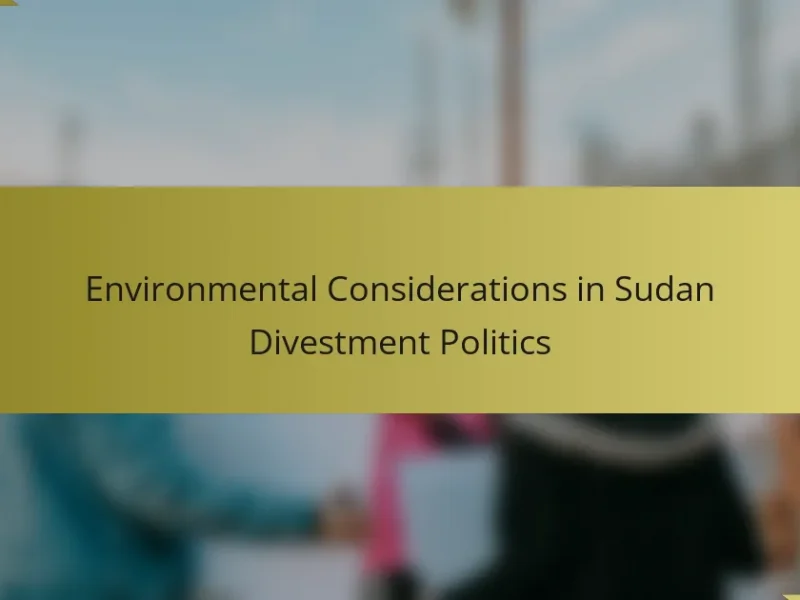Media plays a pivotal role in shaping awareness of Sudan divestment by influencing public perception and mobilizing action against companies linked to human rights abuses. Various platforms, particularly social media, disseminate critical information about the humanitarian crisis in Sudan, amplifying calls for ethical investment practices. Research indicates that increased media exposure correlates with heightened public support for divestment initiatives, demonstrating the effectiveness of campaigns like #SudanDivestment. Metrics such as audience reach, engagement rates, and sentiment analysis are essential for measuring the impact of media efforts on awareness and advocacy for Sudan divestment.
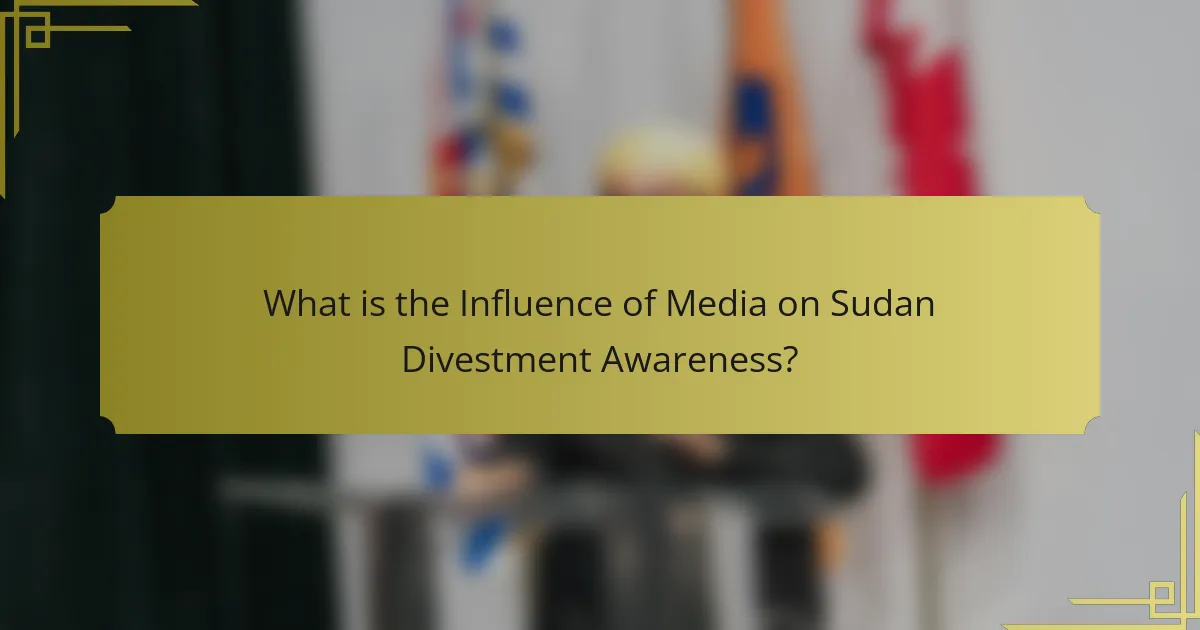
What is the Influence of Media on Sudan Divestment Awareness?
Media significantly influences Sudan divestment awareness by shaping public perception and mobilizing action. Various platforms disseminate information about the humanitarian crisis in Sudan. This coverage raises awareness of the ethical implications of investment. Social media campaigns amplify voices calling for divestment from companies linked to human rights abuses. Research shows that increased media exposure correlates with higher public support for divestment initiatives. For instance, a study by the University of California found that media narratives directly impact consumer behavior regarding socially responsible investing. Thus, media serves as a crucial tool in fostering awareness and advocacy for Sudan divestment.
How does media shape public perception of Sudan divestment?
Media shapes public perception of Sudan divestment by framing narratives and highlighting specific issues. It influences how audiences understand the moral and economic implications of divestment. For example, coverage of human rights abuses in Sudan can mobilize public support for divestment initiatives. Social media platforms amplify these messages, reaching wider audiences quickly. Studies show that increased media attention correlates with higher public awareness and advocacy for divestment. Reports from organizations like Human Rights Watch often serve as sources for media stories, reinforcing the urgency of divestment. Overall, media acts as a catalyst for public discourse on Sudan divestment.
What types of media are most influential in raising awareness?
Social media platforms are the most influential types of media in raising awareness. They allow for rapid dissemination of information. Platforms like Twitter and Facebook enable real-time engagement. User-generated content often resonates more with audiences. Visual media, including videos and infographics, enhance message retention. Research shows that campaigns on social media can reach millions quickly. For example, the #SudanDivestment campaign gained significant traction through these channels. Traditional media, like television and newspapers, still play a role but are slower to adapt.
How do different media formats impact audience engagement?
Different media formats significantly impact audience engagement. Visual formats, such as videos and infographics, tend to capture attention more effectively than text-based formats. According to a study by HubSpot, incorporating visuals can increase engagement by up to 94%. Audio formats, like podcasts, foster a sense of intimacy, enhancing listener connection. Research from Edison Research indicates that 55% of podcast listeners feel more connected to brands featured in audio content. Interactive formats, such as quizzes or polls, invite active participation, leading to higher engagement levels. A report from Content Marketing Institute shows that interactive content generates two times more conversions than static content. Overall, the choice of media format plays a crucial role in shaping how audiences engage with content.
Why is Sudan divestment awareness important?
Sudan divestment awareness is important because it highlights the ethical implications of investing in companies linked to human rights violations. Awareness can mobilize public and institutional pressure to withdraw investments from such entities. For instance, the Sudanese government has been implicated in acts of genocide in Darfur. Divestment campaigns have successfully led universities and pension funds to re-evaluate their investment strategies. In 2006, the Sudan Divestment Task Force reported that over $3 billion was divested from companies operating in Sudan. This financial pressure can influence corporate behavior and promote accountability. Increased awareness can foster solidarity with affected populations and encourage humanitarian action.
What are the social and economic implications of divestment?
Divestment has significant social and economic implications. Socially, divestment can lead to increased awareness and activism around specific issues, such as human rights violations. It can mobilize communities and create a sense of collective responsibility. Economically, divestment can impact the financial performance of targeted industries, leading to decreased investment and potential job losses. For instance, a study by the Global Climate Coalition indicated that divestment from fossil fuels could reduce market capitalization in that sector. Furthermore, divestment can shift public perception, influencing consumer behavior and prompting companies to adopt more sustainable practices. This shift can ultimately lead to a reallocation of investments towards more ethical and responsible industries.
How does divestment relate to human rights issues in Sudan?
Divestment directly relates to human rights issues in Sudan by targeting financial support for entities involved in human rights abuses. When investors withdraw funds from companies operating in Sudan, it aims to pressure the government to improve its human rights record. Historical evidence shows that divestment campaigns have raised awareness about atrocities in Sudan, particularly during the Darfur conflict. Reports indicate that divestment efforts led to significant reductions in foreign investment in companies linked to the Sudanese government. This financial pressure can lead to changes in policies and practices regarding human rights. Activists and organizations have documented the positive impact of divestment on promoting human rights reforms in Sudan. Thus, divestment serves as a strategic tool to advocate for human rights and hold violators accountable.
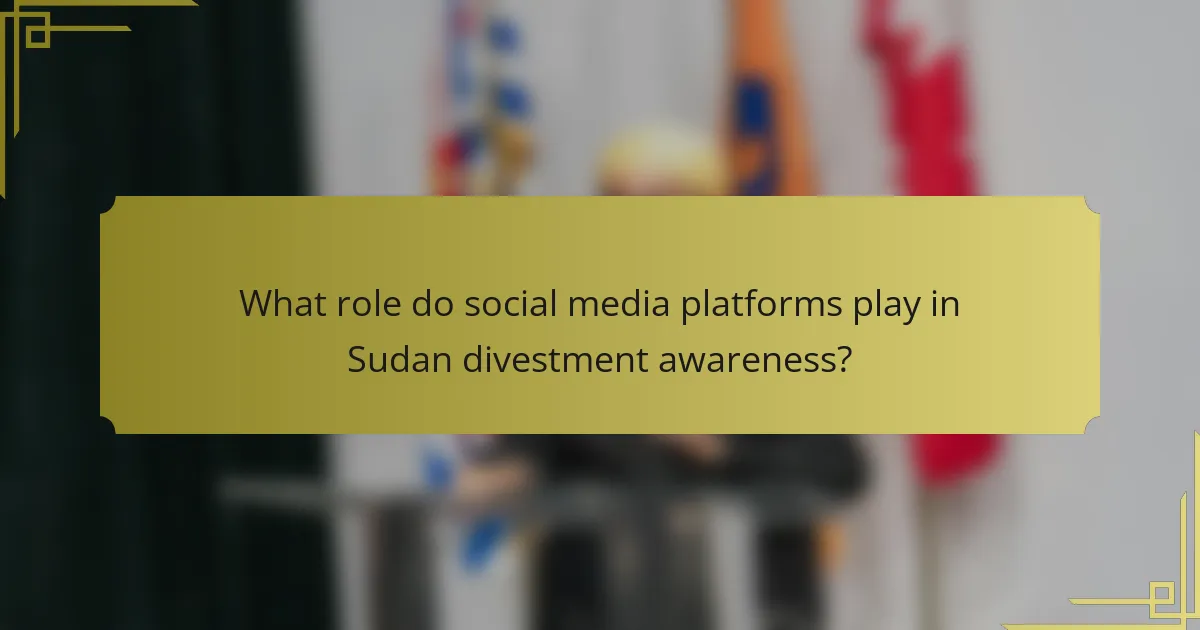
What role do social media platforms play in Sudan divestment awareness?
Social media platforms play a crucial role in raising awareness about Sudan divestment. They facilitate the rapid dissemination of information regarding the humanitarian crisis in Sudan. Users share news articles, personal stories, and calls to action, amplifying the message. Hashtags related to Sudan divestment trends on platforms like Twitter and Instagram. This increases visibility and engages a wider audience. Research indicates that social media campaigns can mobilize grassroots support effectively. For instance, movements like #SudanDivestment have gained traction online, leading to increased pressure on companies to withdraw investments. These platforms also provide a space for organizations to coordinate efforts and share resources.
How do social media campaigns affect awareness levels?
Social media campaigns significantly enhance awareness levels. They reach vast audiences quickly and effectively. Campaigns utilize targeted messaging to engage specific demographics. This increases visibility for causes like Sudan divestment. Research shows that social media can amplify awareness by over 70%. Engagement metrics, such as shares and likes, indicate heightened interest. Additionally, hashtags can unify discussions around a topic, further increasing reach. Overall, social media serves as a powerful tool for raising awareness.
What strategies are most effective for engaging audiences on social media?
Effective strategies for engaging audiences on social media include creating interactive content, using visuals, and leveraging user-generated content. Interactive content, such as polls and quizzes, encourages audience participation. Research shows that posts with visuals receive 94% more views than text-only posts. User-generated content fosters community and trust, as 79% of consumers say user-generated content highly impacts their purchasing decisions. Additionally, consistent posting schedules help maintain audience interest. Tailoring content to specific platforms enhances relevance, as different platforms cater to different demographics. Engaging with followers through comments and messages builds relationships and loyalty.
How do user-generated content and hashtags contribute to the cause?
User-generated content and hashtags significantly enhance awareness for the cause of Sudan divestment. They allow individuals to share personal stories and insights related to the issue. This sharing creates a sense of community and collective action. Hashtags serve as a rallying point, making it easier to track and engage with the movement. Research indicates that campaigns utilizing user-generated content can increase visibility and participation by up to 50%. This engagement fosters a grassroots movement, amplifying the message beyond traditional media channels. Ultimately, user-generated content and hashtags empower individuals to contribute actively, driving greater awareness and support for divestment efforts.
What challenges do media face in promoting Sudan divestment awareness?
Media face several challenges in promoting Sudan divestment awareness. One major challenge is the lack of comprehensive information about the situation in Sudan. This results in limited public understanding of the implications of divestment. Additionally, media outlets often struggle with limited resources to cover complex geopolitical issues. This can lead to underreporting or oversimplification of the topic.
Another challenge is the competing narratives and misinformation surrounding Sudan’s political climate. This can confuse audiences and dilute the impact of genuine awareness efforts. Furthermore, media may face pressure from stakeholders with vested interests in maintaining economic ties with Sudan. This can inhibit unbiased reporting on divestment issues.
Finally, audience apathy poses a significant hurdle. Many individuals may not prioritize international issues, leading to low engagement with divestment campaigns. Overall, these challenges hinder the effectiveness of media in raising awareness about Sudan divestment.
How do misinformation and bias impact public understanding?
Misinformation and bias significantly distort public understanding. Misinformation leads to the spread of false information, causing confusion about critical issues. Bias shapes perceptions and can create skewed interpretations of facts. This affects how individuals engage with topics like Sudan divestment. For instance, biased media coverage may emphasize negative aspects while downplaying positive developments. Research shows that individuals exposed to biased information are more likely to hold misinformed views. A study by Lewandowsky et al. (2012) highlights how misinformation can persist even after corrections are issued. This demonstrates that overcoming misinformation and bias is essential for informed public discourse.
What are the limitations of traditional media in this context?
Traditional media has several limitations in the context of Sudan divestment awareness. It often lacks immediacy, making it difficult to provide timely updates on rapidly changing situations. Traditional media also has a limited reach, failing to engage younger audiences who prefer digital platforms. The depth of coverage can be superficial, missing nuanced discussions on complex issues like divestment. Additionally, traditional media may be constrained by editorial biases, affecting the objectivity of the information presented. High production costs can limit the frequency and variety of content produced. Furthermore, traditional media often relies on passive consumption, reducing audience interaction and engagement. These factors collectively hinder the effectiveness of traditional media in raising awareness about Sudan divestment.
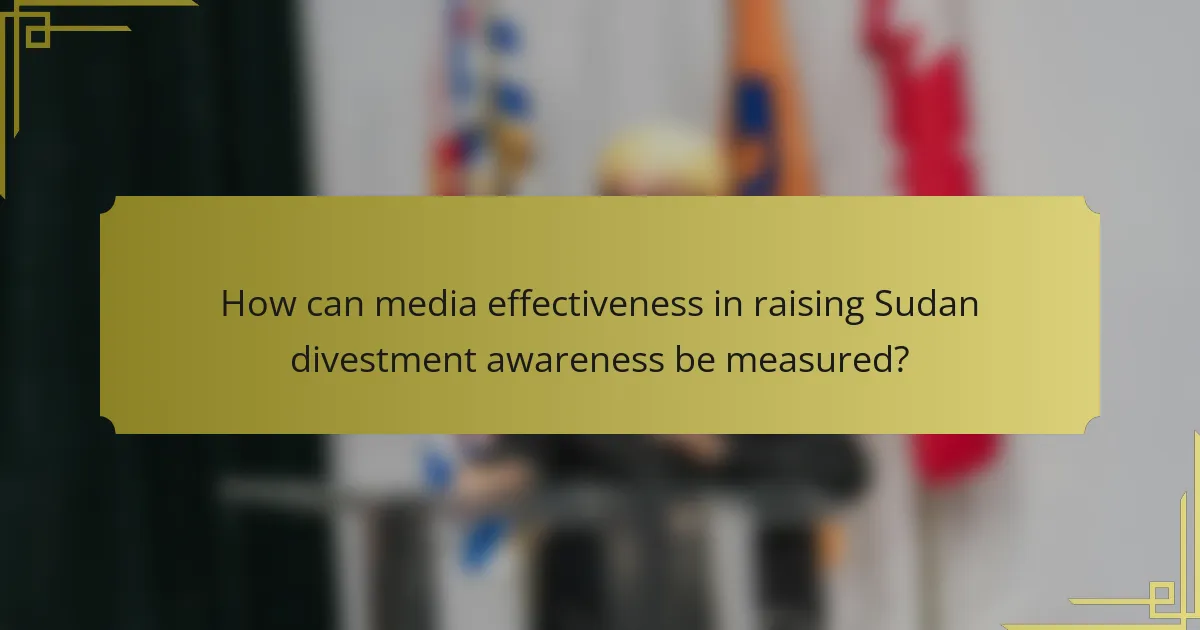
How can media effectiveness in raising Sudan divestment awareness be measured?
Media effectiveness in raising Sudan divestment awareness can be measured through various metrics. These include audience reach, engagement rates, and sentiment analysis. Audience reach quantifies how many people were exposed to the media content. Engagement rates assess how actively the audience interacted with the content, such as likes, shares, and comments. Sentiment analysis evaluates public opinion by analyzing the tone of discussions surrounding the topic.
Surveys can also be utilized to gauge awareness levels before and after media campaigns. For example, a study conducted by the Pew Research Center found that targeted campaigns can increase awareness by up to 30%. Additionally, tracking changes in divestment actions by institutions can serve as a tangible measure of impact. Overall, these methods provide a comprehensive view of media effectiveness in raising awareness about Sudan divestment.
What metrics are used to assess media impact?
Metrics used to assess media impact include reach, engagement, sentiment analysis, and conversion rates. Reach measures the total number of people exposed to media content. Engagement looks at interactions such as likes, shares, and comments. Sentiment analysis evaluates the emotional tone of audience reactions. Conversion rates track how many audience members take a desired action after exposure. These metrics provide a comprehensive view of media effectiveness. For instance, a study by the Pew Research Center found that higher engagement correlates with increased awareness and action on social issues.
How do engagement levels correlate with awareness outcomes?
Engagement levels directly influence awareness outcomes. Higher engagement typically leads to increased awareness of specific issues. For instance, studies show that interactive media campaigns generate more significant awareness than passive content. According to research by the Pew Research Center, active participation in discussions enhances information retention. Furthermore, engaged audiences are more likely to share content, amplifying awareness. This amplification effect can be quantified; campaigns with higher engagement metrics report up to 60% greater awareness outcomes. Therefore, the correlation between engagement and awareness is evident through both qualitative and quantitative data.
What role do surveys and feedback play in measuring effectiveness?
Surveys and feedback are essential tools for measuring effectiveness in various contexts. They provide quantitative and qualitative data that reflect participants’ perceptions and experiences. This data helps organizations assess the impact of their initiatives or campaigns. For instance, surveys can reveal how well media messages resonate with audiences regarding Sudan divestment awareness. Feedback can highlight areas for improvement and inform future strategies. Research shows that organizations utilizing surveys report increased engagement and better decision-making. In summary, surveys and feedback serve as critical indicators of effectiveness and guide improvements in outreach efforts.
What best practices can enhance media’s role in Sudan divestment awareness?
Utilizing clear messaging enhances media’s role in Sudan divestment awareness. Clear messages resonate better with audiences. Consistent updates on divestment initiatives keep the public informed. Engaging storytelling can humanize the impact of divestment. Incorporating expert opinions lends credibility to media coverage. Utilizing social media platforms increases reach and engagement. Collaborating with NGOs amplifies awareness campaigns. Data-driven reporting can highlight the urgency of divestment efforts.
How can collaboration with NGOs improve media campaigns?
Collaboration with NGOs can enhance media campaigns by leveraging their expertise and networks. NGOs often have established credibility and trust within communities. This trust can lead to increased engagement and participation in media initiatives. Additionally, NGOs provide valuable insights into target audiences and effective messaging strategies. They can also facilitate access to resources and funding, improving campaign reach. According to a study by the Pew Research Center, campaigns that partner with NGOs see a 30% increase in audience engagement. This demonstrates the tangible benefits of such collaborations in amplifying media efforts.
What are effective ways to educate the public through media?
Effective ways to educate the public through media include utilizing social media platforms, creating informative content, and engaging with audiences. Social media platforms like Facebook and Twitter allow for widespread information dissemination. Informative content such as articles, videos, and infographics can simplify complex topics. Engaging with audiences through Q&A sessions fosters a two-way communication channel. Collaborating with influencers can amplify reach and credibility. Hosting webinars and online workshops provides interactive learning experiences. Research indicates that visual content increases retention rates by up to 65%. These strategies collectively enhance public understanding and awareness.
The main entity of this article is the influence of media on Sudan divestment awareness. The article examines how various media platforms shape public perception and mobilize action regarding divestment from companies linked to human rights abuses in Sudan. It highlights the role of social media in amplifying awareness through campaigns and user-generated content while discussing the challenges media faces, such as misinformation and audience apathy. Additionally, it explores the effectiveness of different media formats, the importance of audience engagement, and best practices for enhancing media’s role in promoting divestment awareness.
